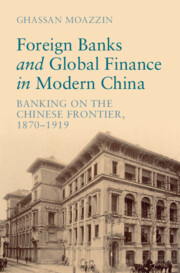Refine search
Actions for selected content:
26944 results in Economic history
Appendix 2 - Foreign Bank Branches/Agencies and Agents in Major Chinese Ports with Number of Employees, 1908
-
- Book:
- Foreign Banks and Global Finance in Modern China
- Published online:
- 22 June 2022
- Print publication:
- 07 July 2022, pp 285-287
-
- Chapter
- Export citation
Conclusion
-
- Book:
- Foreign Banks and Global Finance in Modern China
- Published online:
- 22 June 2022
- Print publication:
- 07 July 2022, pp 265-276
-
- Chapter
- Export citation
Bibliography
-
- Book:
- Foreign Banks and Global Finance in Modern China
- Published online:
- 22 June 2022
- Print publication:
- 07 July 2022, pp 288-321
-
- Chapter
- Export citation
Contents
-
- Book:
- Foreign Banks and Global Finance in Modern China
- Published online:
- 22 June 2022
- Print publication:
- 07 July 2022, pp vii-vii
-
- Chapter
- Export citation
2 - Entering the Chinese Banking Sector
-
- Book:
- Foreign Banks and Global Finance in Modern China
- Published online:
- 22 June 2022
- Print publication:
- 07 July 2022, pp 56-108
-
- Chapter
- Export citation
Index
-
- Book:
- Foreign Banks and Global Finance in Modern China
- Published online:
- 22 June 2022
- Print publication:
- 07 July 2022, pp 322-334
-
- Chapter
- Export citation
Figures
-
- Book:
- Foreign Banks and Global Finance in Modern China
- Published online:
- 22 June 2022
- Print publication:
- 07 July 2022, pp viii-ix
-
- Chapter
- Export citation
Abbreviations
-
- Book:
- Foreign Banks and Global Finance in Modern China
- Published online:
- 22 June 2022
- Print publication:
- 07 July 2022, pp xvi-xviii
-
- Chapter
- Export citation
5 - Global Markets, International Finance and the 1911 Revolution in China
-
- Book:
- Foreign Banks and Global Finance in Modern China
- Published online:
- 22 June 2022
- Print publication:
- 07 July 2022, pp 188-228
-
- Chapter
- Export citation
Copyright page
-
- Book:
- Foreign Banks and Global Finance in Modern China
- Published online:
- 22 June 2022
- Print publication:
- 07 July 2022, pp iv-iv
-
- Chapter
- Export citation
Appendix 1 - Deutsch-Asiatische Bank Loans to the Chinese Central and Provincial Governments, 1890–1916
-
- Book:
- Foreign Banks and Global Finance in Modern China
- Published online:
- 22 June 2022
- Print publication:
- 07 July 2022, pp 277-284
-
- Chapter
- Export citation
Map
-
- Book:
- Foreign Banks and Global Finance in Modern China
- Published online:
- 22 June 2022
- Print publication:
- 07 July 2022, pp xix-xx
-
- Chapter
- Export citation
Tables
-
- Book:
- Foreign Banks and Global Finance in Modern China
- Published online:
- 22 June 2022
- Print publication:
- 07 July 2022, pp x-x
-
- Chapter
- Export citation
3 - Chinese Bonds for European Investors
-
- Book:
- Foreign Banks and Global Finance in Modern China
- Published online:
- 22 June 2022
- Print publication:
- 07 July 2022, pp 109-149
-
- Chapter
- Export citation
4 - Railway Dreams
-
- Book:
- Foreign Banks and Global Finance in Modern China
- Published online:
- 22 June 2022
- Print publication:
- 07 July 2022, pp 150-187
-
- Chapter
- Export citation
The limits of control: corporate ownership and control of German joint-stock firms, 1869–1945
-
- Journal:
- Financial History Review / Volume 29 / Issue 2 / August 2022
- Published online by Cambridge University Press:
- 06 July 2022, pp. 152-197
-
- Article
-
- You have access
- Open access
- HTML
- Export citation

Foreign Banks and Global Finance in Modern China
- Banking on the Chinese Frontier, 1870-1919
-
- Published online:
- 22 June 2022
- Print publication:
- 07 July 2022
2 - Contract
-
- Book:
- Debt, Trust, and Reputation
- Published online:
- 30 November 2021
- Print publication:
- 16 June 2022, pp 12-65
-
- Chapter
- Export citation
References
-
- Book:
- Debt, Trust, and Reputation
- Published online:
- 30 November 2021
- Print publication:
- 16 June 2022, pp 350-365
-
- Chapter
- Export citation
Index
-
- Book:
- Debt, Trust, and Reputation
- Published online:
- 30 November 2021
- Print publication:
- 16 June 2022, pp 366-372
-
- Chapter
- Export citation
